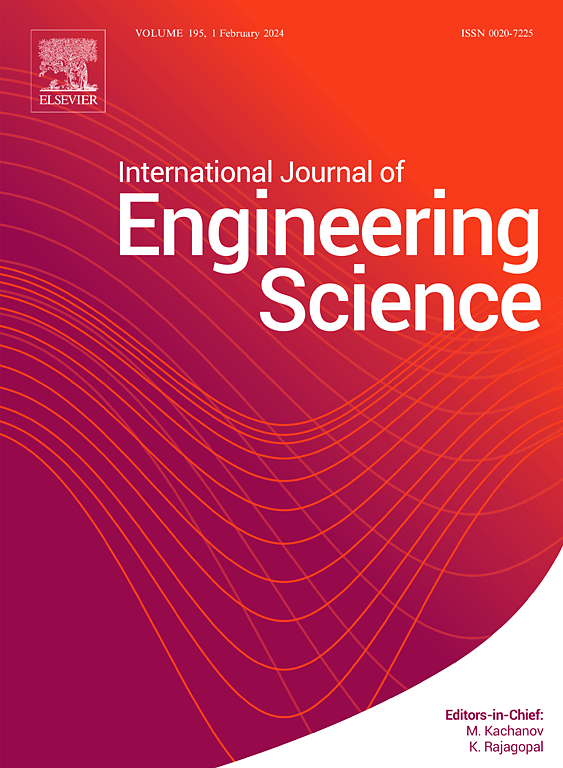左冠状动脉壁模型对血流动力学影响的比较数值研究
IF 5.7
1区 工程技术
Q1 ENGINEERING, MULTIDISCIPLINARY
International Journal of Engineering Science
Pub Date : 2025-07-31
DOI:10.1016/j.ijengsci.2025.104358
引用次数: 0
摘要
血液动力学变量对于了解心血管疾病的进展至关重要,但其准确性取决于对动脉壁行为的假设。尽管有报道称左冠状动脉(LCA)的左前降支(LAD)极易发生动脉粥样硬化,但在这种情况下,比较不同壁模型的影响的研究明显缺乏。本研究采用双向流固相互作用(FSI)模拟来研究刚性、弹性和超弹性壁模型对理想LCA中中度狭窄LAD分支血流动力学的影响。血液的非牛顿特性是用卡罗黏度模型捕获的。主要的血流动力学参数——初级速度(Vp)、流向涡度、时间平均壁剪切应力(TAWSS)、振荡剪切指数(OSI)、相对停留时间(RRT)和分流储备(FFR)——通过这些模型进行了评估。结果表明:与弹性和超弹性模型相比,刚性模型在狭窄喉部表现出更高的Vp和TAWSS;相对于弹性模型和超弹性模型,TAWSS峰值分别高估了6.22%和14.46%,这表明刚性壁斑块破裂的风险更高。在斑块进展方面,与刚性和弹性模型相比,超弹性模型中动脉壁的狭窄前和狭窄后区域都显示出最广泛的受影响区域,表现为严重的负vpp和TAWSS的极低值,以及OSI和RRT的极高值。超弹性模型的FFR值最高(0.95),其次是弹性模型(0.94)和刚性模型(0.91)。这些发现强调了将动脉壁柔韧性纳入血流动力学研究以提高风险评估和临床准确性的重要性。本文章由计算机程序翻译,如有差异,请以英文原文为准。
Effect of wall models on hemodynamics in left coronary artery: A comparative numerical study
Hemodynamic variables are vital for understanding the progression of cardiovascular diseases, but their accuracy depends on assumptions about arterial wall behaviour. Although the left anterior descending (LAD) branch of the left coronary artery (LCA) has been reported to be highly susceptible to atherosclerosis, there is a significant lack of studies comparing the effects of different wall models in this context. This study employs two-way fluid-structure interaction (FSI) simulations to investigate the impact of rigid, elastic, and hyperelastic wall models on the hemodynamics of a moderately stenosed LAD branch in an idealised LCA. The non-Newtonian properties of blood are captured using the Carreau viscosity model. Key hemodynamic parameters—primary velocity (), streamwise vorticity, time-averaged wall shear stress (TAWSS), oscillatory shear index (OSI), relative residence time (RRT), and fractional flow reserve (FFR)—are evaluated across these models. Results show that the rigid model mostly exhibits higher and TAWSS at the stenosis throat compared to the elastic and hyperelastic models. It overestimates the peak TAWSS by 6.22 % and 14.46 % relative to the elastic and hyperelastic models, respectively, suggesting a higher risk of plaque rupture in rigid walls. In terms of plaque progression, both the pre- and post-stenotic regions of the arterial wall show the most extensive affected areas in the hyperelastic model compared to the rigid and elastic models, indicated by severe negative and critically low values of TAWSS, and critically high values of OSI and RRT. The FFR value is the highest for the hyperelastic model (0.95), followed by the elastic (0.94) and rigid models (0.91). These findings underscore the importance of incorporating arterial wall flexibility in hemodynamic studies to improve risk assessment and clinical accuracy.
求助全文
通过发布文献求助,成功后即可免费获取论文全文。
去求助
来源期刊

International Journal of Engineering Science
工程技术-工程:综合
CiteScore
11.80
自引率
16.70%
发文量
86
审稿时长
45 days
期刊介绍:
The International Journal of Engineering Science is not limited to a specific aspect of science and engineering but is instead devoted to a wide range of subfields in the engineering sciences. While it encourages a broad spectrum of contribution in the engineering sciences, its core interest lies in issues concerning material modeling and response. Articles of interdisciplinary nature are particularly welcome.
The primary goal of the new editors is to maintain high quality of publications. There will be a commitment to expediting the time taken for the publication of the papers. The articles that are sent for reviews will have names of the authors deleted with a view towards enhancing the objectivity and fairness of the review process.
Articles that are devoted to the purely mathematical aspects without a discussion of the physical implications of the results or the consideration of specific examples are discouraged. Articles concerning material science should not be limited merely to a description and recording of observations but should contain theoretical or quantitative discussion of the results.
 求助内容:
求助内容: 应助结果提醒方式:
应助结果提醒方式:


